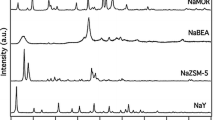Abstract
The mechanism of a low-temperature reaction of hydrogen with the radical anion surface oxygen species (α-oxygen, Оα) formed by decomposing N2O over FeZSM-5 zeolite was studied using kinetic and isotope techniques. It was found that the reaction is of first order with respect to hydrogen and the rate of the reaction is proportional to the concentration of Оα. The activation energy of the reaction, which was measured for Н2 or D2 over a temperature range from +20 to –;;100°С, is equal to 3.2 or 5.3 kcal/mol, respectively. The reaction occurs with a considerable kinetic isotope effect (k Н/k D), which varies over the range of 3.4–;;41 depending on the temperature. This fact indicates that the rate-limiting step of the reaction includes the dissociation of the hydrogen molecule. The temperature dependence of the isotope effect gave a value of 2.1 kcal/mol, which is close to the difference between the zero bond energies in the molecules of Н2 and D2; this fact suggests that a tunnel effect does not significantly contribute to the reaction. The dissociative mechanism is consistent with data obtained by in situ IR spectroscopy. The interaction of hydrogen with α-oxygen is accompanied by the formation of new hydroxyl groups ОαН (absorption bands at 3635 and 3674 cm–;;1) at the surface of the zeolite. The identification of these groups was supported by an isotope shift either on the replacement of Н2 by D2 or on the replacement of 16Оα by 18Оα. The stoichiometric ratio Н2 : Оα is consistent with the previously drawn conclusion on the paired arrangement of α-sites.
Similar content being viewed by others
REFERENCES
Sobolev, V.I., Panov, G.I., Kharitonov, A.S., Romannikov, V.N., Volodin, A.M., and Ione, K.G., J. Catal., 1993, vol. 139, p. 435.
Panov, G.I., Sobolev, V.I., and Kharitonov, A.S., Appl. Catal., 1993, vol. 98, p. 1.
Filatov, M.J., Pelmenschikov, A.G., and Zhidomirov, G.M., J. Mol. Catal., 1993, vol. 8, p. 243.
Vereshchagin, S.N., Kirik, N.P., Shishkina, N.N., and Anshits, A.G., Catal. Lett., 1998, vol. 56, p. 145.
Voskoboinikov, T.V., Chen, H.-Y., and Sachtler, W.M.H., Appl. Catal., 1998, vol. 19, p. 279.
Yoshizawa, K., Shiota, Y., Yumura, T., and Yamabe, T., J. Phys. Chem. B, 2000, vol. 104, p. 734.
Ribera, A., Arends, I.W.C.E., de Vries, S., Perez-Ramirez, J., and Sheldon, R.A., J. Catal., 2000, vol. 195, p. 287.
Dubkov, K.A., Ovanesyan, N.S., Shteinman, A.A., Starokon, E.V., and Panov, G.I., J. Catal., 2002, vol. 207, p. 341.
Starokon, E.V., Dubkov, K.A., and Panov, G.I., Top. Catal., 2003, vol. 23,nos. 1–;;4, p. 137.
Kharitonov, A.S., Aleksandrova, T.N., Panov, G.I., Sobolev, V.I., Sheveleva, G.A., and Paukshtis, E.A., Kinet. Katal., 1994, vol. 35,no. 2, p. 296.
Dubkov, K.A., Sobolev, V.I., and Panov, G.I., Kinet. Katal., 1998, vol. 39,no. 1, p. 79.
Rodkin, M.A., Sobolev, V.I., Dubkov, K.A., Watkins, N.H., and Panov, G.I., Stud. Surf. Sci. Catal., 2000, vol. 130, p. 875.
Dubkov, K.A., Paukshtis, E.A., and Panov, G.I., Kinet. Katal., 2001, vol. 42,no. 2, p. 230.
Lipatkina, N.I., Shvets, V.A., and Kazanskii, V.B., Kinet. Katal., 1978, vol. 19,no. 4, 979.
US Patent 5077026, 1991.
Dubkov, K.A., Sobolev, V.I., Talsi, E.P., Rodkin, M.A., Watkins, N.H., Shteinman, A.A., and Panov, G.I., J. Mol. Catal., 1997, vol. 123, p. 155.
Ozaki, A., Isotopic Studies of Heterogeneous Catalysis, Moscow: London: Academic, 1977.
Khenkin, A.M. and Shilov, A.E., New J. Chem., 1989, vol. 13, p. 659.
Jacobs, P.A. and von Ballmoos, R., J. Phys. Chem., 1982, vol. 86, p. 3050.
Quin, G., Zheng, L., Xie, Y., and Wu, C., J. Catal., 1985, vol. 95, p. 609.
Kustov, L.M., Kazansky, V.B., Kubelkova, L., and Jiru, P., J. Phys. Chem., 1987, vol. 91, p. 5247.
Bordiga, S., Platero, E.E., Arean, C.O., Lamberti, C., and Zecchina, A., J. Catal., 1992, vol. 137, p. 179.
Zholobenko, V., Mendeleev Commun., 1993, vol. 2, p. 67.
Panov, G.I., Dubkov, K.A., and Paukshtis, E.A., Catalysis by Unique Metal Ion Structures in Solid Matrices, Centi, G., Wichterlowa, B., and Bell, A., Eds., Dordrecht: Kluwer Academic, 2001, p. 149.
Author information
Authors and Affiliations
Rights and permissions
About this article
Cite this article
Dubkov, K.A., Starokon', E.V., Paukshtis, E.A. et al. Mechanism of the Low-Temperature Interaction of Hydrogen with α-Oxygen on FeZSM-5 Zeolite. Kinetics and Catalysis 45, 202–208 (2004). https://doi.org/10.1023/B:KICA.0000023792.95153.d8
Issue Date:
DOI: https://doi.org/10.1023/B:KICA.0000023792.95153.d8




